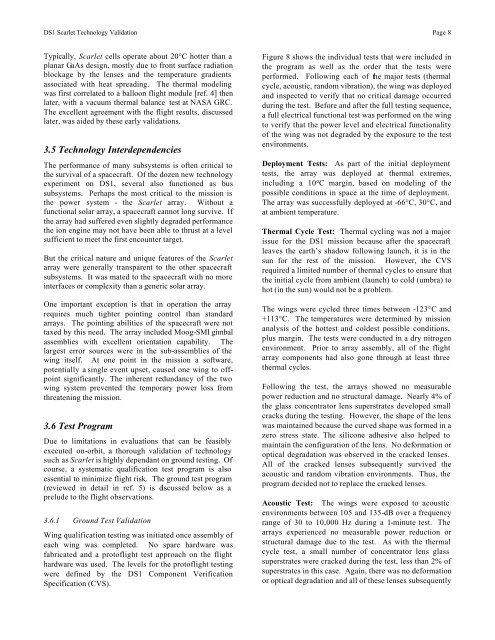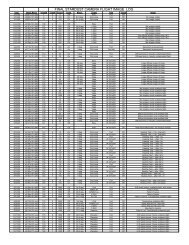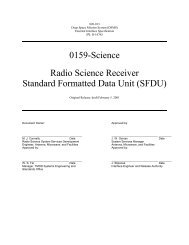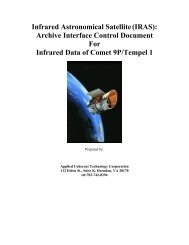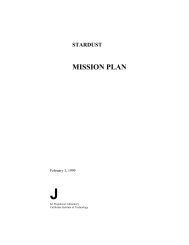The Scarlet Solar Array - PDS Small Bodies Node
The Scarlet Solar Array - PDS Small Bodies Node
The Scarlet Solar Array - PDS Small Bodies Node
- No tags were found...
Create successful ePaper yourself
Turn your PDF publications into a flip-book with our unique Google optimized e-Paper software.
DS1 <strong>Scarlet</strong> Technology Validation Page 8<br />
Typically, <strong>Scarlet</strong> cells operate about 20°C hotter than a<br />
planar GaAs design, mostly due to front surface radiation<br />
blockage by the lenses and the temperature gradients<br />
associated with heat spreading. <strong>The</strong> thermal modeling<br />
was first correlated to a balloon flight module [ref. 4] then<br />
later, with a vacuum thermal balance test at NASA GRC.<br />
<strong>The</strong> excellent agreement with the flight results, discussed<br />
later, was aided by these early validations.<br />
3.5 Technology Interdependencies<br />
<strong>The</strong> performance of many subsystems is often critical to<br />
the survival of a spacecraft. Of the dozen new technology<br />
experiment on DS1, several also functioned as bus<br />
subsystems. Perhaps the most critical to the mission is<br />
the power system - the <strong>Scarlet</strong> array. Without a<br />
functional solar array, a spacecraft cannot long survive. If<br />
the array had suffered even slightly degraded performance<br />
the ion engine may not have been able to thrust at a level<br />
sufficient to meet the first encounter target.<br />
But the critical nature and unique features of the <strong>Scarlet</strong><br />
array were generally transparent to the other spacecraft<br />
subsystems. It was mated to the spacecraft with no more<br />
interfaces or complexity than a generic solar array.<br />
One important exception is that in operation the array<br />
requires much tighter pointing control than standard<br />
arrays. <strong>The</strong> pointing abilities of the spacecraft were not<br />
taxed by this need. <strong>The</strong> array included Moog-SMI gimbal<br />
assemblies with excellent orientation capability. <strong>The</strong><br />
largest error sources were in the sub-assemblies of the<br />
wing itself. At one point in the mission a software,<br />
potentially a single event upset, caused one wing to offpoint<br />
significantly. <strong>The</strong> inherent redundancy of the two<br />
wing system prevented the temporary power loss from<br />
threatening the mission.<br />
3.6 Test Program<br />
Due to limitations in evaluations that can be feasibly<br />
executed on-orbit, a thorough validation of technology<br />
such as <strong>Scarlet</strong> is highly dependant on ground testing. Of<br />
course, a systematic qualification test program is also<br />
essential to minimize flight risk. <strong>The</strong> ground test program<br />
(reviewed in detail in ref. 5) is discussed below as a<br />
prelude to the flight observations.<br />
3.6.1 Ground Test Validation<br />
Wing qualification testing was initiated once assembly of<br />
each wing was completed. No spare hardware was<br />
fabricated and a protoflight test approach on the flight<br />
hardware was used. <strong>The</strong> levels for the protoflight testing<br />
were defined by the DS1 Component Verification<br />
Specification (CVS).<br />
Figure 8 shows the individual tests that were included in<br />
the program as well as the order that the tests were<br />
performed. Following each of the major tests (thermal<br />
cycle, acoustic, random vibration), the wing was deployed<br />
and inspected to verify that no critical damage occurred<br />
during the test. Before and after the full testing sequence,<br />
a full electrical functional test was performed on the wing<br />
to verify that the power level and electrical functionality<br />
of the wing was not degraded by the exposure to the test<br />
environments.<br />
Deployment Tests: As part of the initial deployment<br />
tests, the array was deployed at thermal extremes,<br />
including a 10°C margin, based on modeling of the<br />
possible conditions in space at the time of deployment.<br />
<strong>The</strong> array was successfully deployed at -66°C, 30°C, and<br />
at ambient temperature.<br />
<strong>The</strong>rmal Cycle Test: <strong>The</strong>rmal cycling was not a major<br />
issue for the DS1 mission because after the spacecraft<br />
leaves the earth’s shadow following launch, it is in the<br />
sun for the rest of the mission. However, the CVS<br />
required a limited number of thermal cycles to ensure that<br />
the initial cycle from ambient (launch) to cold (umbra) to<br />
hot (in the sun) would not be a problem.<br />
<strong>The</strong> wings were cycled three times between -123°C and<br />
+113°C. <strong>The</strong> temperatures were determined by mission<br />
analysis of the hottest and coldest possible conditions,<br />
plus margin. <strong>The</strong> tests were conducted in a dry nitrogen<br />
environment. Prior to array assembly, all of the flight<br />
array components had also gone through at least three<br />
thermal cycles.<br />
Following the test, the arrays showed no measurable<br />
power reduction and no structural damage. Nearly 4% of<br />
the glass concentrator lens superstrates developed small<br />
cracks during the testing. However, the shape of the lens<br />
was maintained because the curved shape was formed in a<br />
zero stress state. <strong>The</strong> silicone adhesive also helped to<br />
maintain the configuration of the lens. No deformation or<br />
optical degradation was observed in the cracked lenses.<br />
All of the cracked lenses subsequently survived the<br />
acoustic and random vibration environments. Thus, the<br />
program decided not to replace the cracked lenses.<br />
Acoustic Test: <strong>The</strong> wings were exposed to acoustic<br />
environments between 105 and 135-dB over a frequency<br />
range of 30 to 10,000 Hz during a 1-minute test. <strong>The</strong><br />
arrays experienced no measurable power reduction or<br />
structural damage due to the test. As with the thermal<br />
cycle test, a small number of concentrator lens glass<br />
superstrates were cracked during the test, less than 2% of<br />
superstrates in this case. Again, there was no deformation<br />
or optical degradation and all of these lenses subsequently


